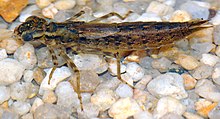larva

Larva (from Latin larva Pl. Larvae ) describes in zoology an intermediate form in the development from the egg to the adult stage . It occurs in animals that are going through a metamorphosis . Originally larva referred to a mask or a ghost .
The best-known groups of animals with a larval stage are the insects and amphibians . The larvae of frogs are called tadpoles ; as Finns refers to the larval stage in tapeworms . Examples of larvae in insects are maggots or caterpillars . Many egg-laying fish also have one or more larval stages. The designation of different larval stages is often abbreviated as L1, L2, etc. Larvae look completely different from the adult and often have a completely different way of life. For example, the larvae of mosquitoes or dragonflies live in the water, while the adult insect ( imago ) lives on land. If the young animals do not have their own larval characteristics, one speaks of a nymph .
The larval period does not always have to be a short transition phase ; it can well make up most of an animal's life. The cockchafer, for example, lives two to five years as a larva ( grubs ), as a fully grown beetle only a few weeks. It looks extreme with the mayflies . After the transformation to the imago , some species only live a few hours. Furthermore, there are species in which the larvae become sexually mature and never carry out the transformation (so-called neoteny ), for example the Mexican axolotl newt.
Rat tail larva (Eristaliini) and tadpole (Tadpoles)
Larva of the black beetle ( Zophobas morio )
Stonefly larva ( Plecoptera )
freshly hatched fish larva of an Atlantic salmon ( Salmo salar )
Greenhouse whitefly larva taken with a light microscope
literature
- Detlef Bückmann : About the course and the triggering of behavioral changes and discoloration of adult caterpillars. In: Biological Zentralblatt. Vol. 72, Issue 5/6, 1953, ISSN 0006-3304 , pp. 276-311.





